Rooster with pasta and tomato sauce (Kokora kokkinisto me makaronia)
A traditional Greek recipe of rooster stewed in a rich and fragrant tomato sauce. This meal is typically served over thick pasta noodles that are coated generously with grated mizithra cheese. Kokora kokkinisto me makaronia as it is called in Greek, is a meal that is often served on New Year’s Day.
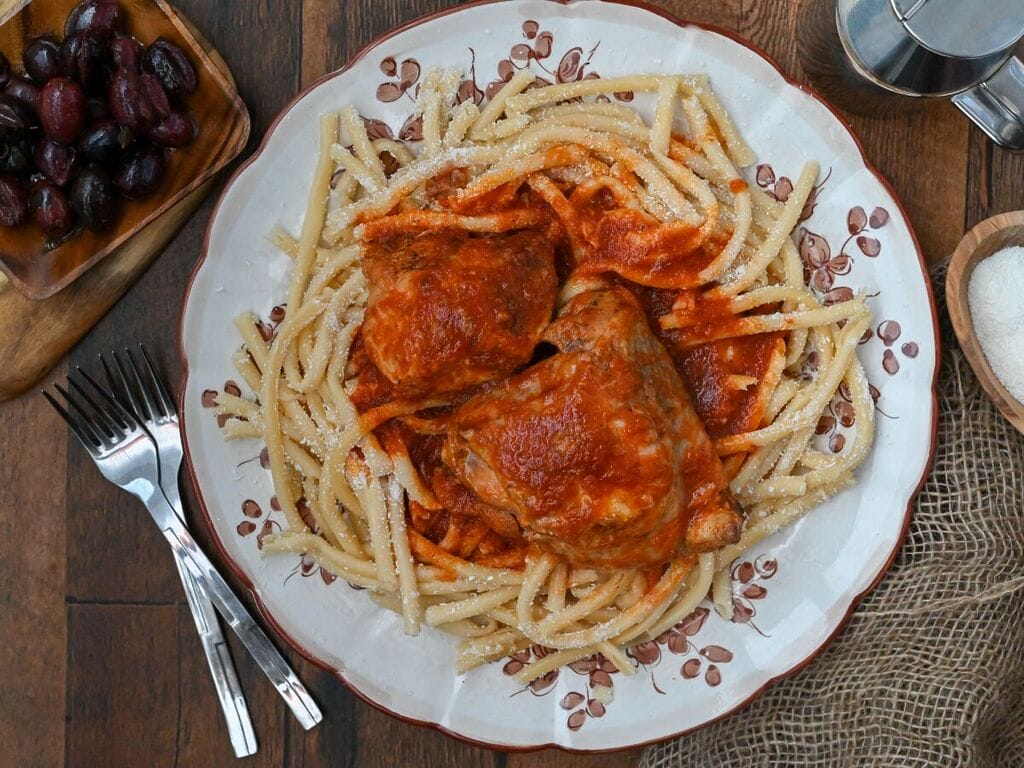
Μακαρονάδα με κόκορα κοκκινιστό. If you want to talk traditional Greek recipes, this is definitely one for discussion. Rooster with pasta and tomato sauce (or Kokora me makaronia as it is called in Greek) is humble, real Greek food. It is also the meal my Greek family usually serves on New Year’s Day. Follow this by the traditional Greek New Year’s cake called Vasilopita (or a modern twist of Vasilopita cupcakes) and you have a great Greek feast, perfect to start the year!
In Greek cooking there is an entire category of meals called kokkinista; this essentially means reddened – referring to the fact that the meat (primarily) is slowly stewed in a rich tomato sauce. Kokkinista are real comfort food, and the meat protein is often served alongside pasta, rice or potatoes. Other examples of kokkinista include Chicken kokkinisto with french fries, Veal kokkinisto with rice and Chicken kokkinisto with french fries.
Why I love this recipe
Well, honestly the first reason I love sharing this recipe is because people are often amazed and ask, We can eat rooster?! Yes – of course you can eat roosterI Would I share a recipe with non-edible ingredients?! You may actually remember that I have already shared a rooster recipe with you all Stewed rooster with okra and potatoes. It brings me joy to be able to open up the world of food to many of you, introducing you to ingredients you may have never had before.
The great thing about a meal like rooster with pasta and tomato sauce (kokora me makaronia) is that is it pretty easy to put together. It is hearty, but incredibly simple – a very uncomplicated way to feed a crowd. You can easily double this recipe if you need to.
Finally, as Helen and I have always said, nostalgia is delicious. If you read on to learn about my family’s New Year’s traditions, you will see that this meal was a mainstay of our New Year’s Day celebration. That is enough to make me love it (it helps that it is delicious too of course!).
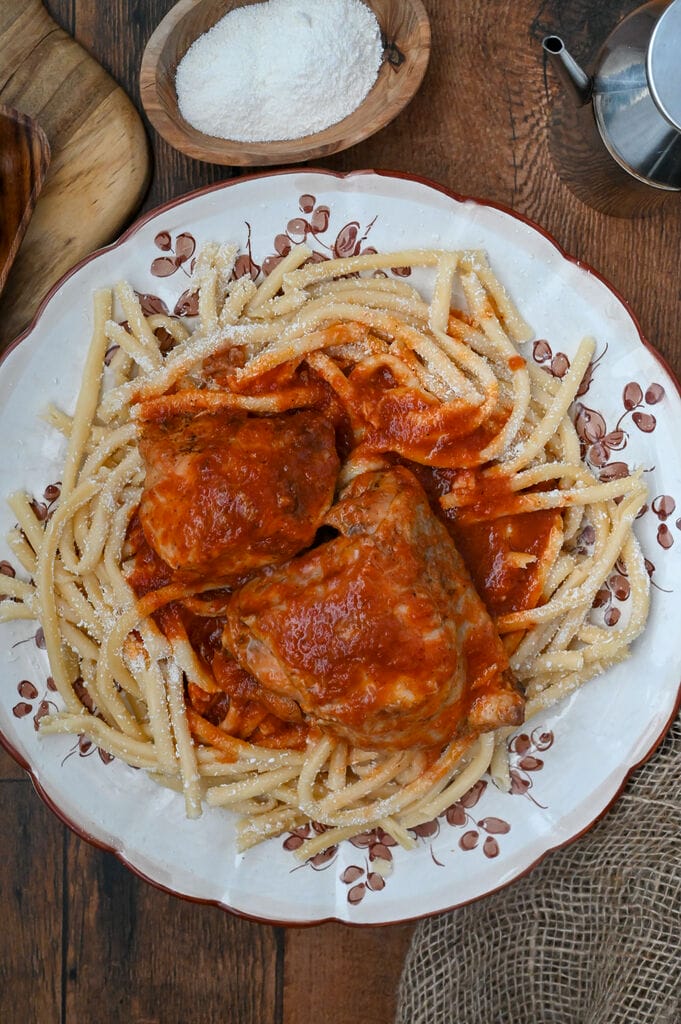
Key ingredients
As you can see, there are very few ingredients needed to make this classic Greek meal.
Rooster Although rooster is not as common as chicken, it should be! This large fowl is delicious, lean and is actually a chicken, but a male one! They tend to be larger than what we commonly call chickens (which are technically hens) and so this recipe only uses half the bird, assuming you will be serving 4 people.
Tomato sauce When you are only using a few ingredients, you want to be sure that they are great ingredients! I like to use my homemade tomato sauce. If you don’t want to make sauce, use a good quality passata instead.
Olive oil I only use Greek olive oil. I use it to brown my rooster pieces, and then I also pour some into the pot to help make the sauce. So rich and delicious!
Boiling water I boil the water before I add it to the pot. You can technically use tap water that has not been boiled, but I like to give the sauce a head start to boiling.
Cinnamon In Greek cooking it is common to add cinnamon to savoury dishes. It gives a really unique and delicious flavour. – don’t skip it!
Pasta The ideal pasta to use in this recipe is a thick long noodle like the one you would use to make Pastitsio, or something a bit thinner. Sometimes these noodles are called bucatini noodles.
Mizithra cheese This is the hard cheese made from sheep and goat’s milk that is used the way many people would use parmesan cheese; that is, on top of pasta. It is salty and absolutely delicious. When I buy my mizithra from the Greek market, I ask them to grate it for me into a finely grated cheese. I store the excess in my freezer for longer storage.
Salt & pepper It goes without saying that most recipes benefit from salt and pepper!
How to make it
I love making this meal thoughout the year, but especially for lunch on New Year’s Day. This is because it feeds a crowd, but is also really easy to make – perfect when you are tired from New Year’s Eve celebrations (or simply from staying awake until midnight!).
Step 1
Season the rooster with salt and pepper. Then, add olive oil to a large frying pan (enough so that you have ¼ inch of oil in pan) Heat over medium heat and begin frying the rooster. Do not overcrowd your pan; you will likely have to do this in batches. Fry the rooster until browned on all sides (about 5 minutes per side). Transfer the rooster to a large pot.
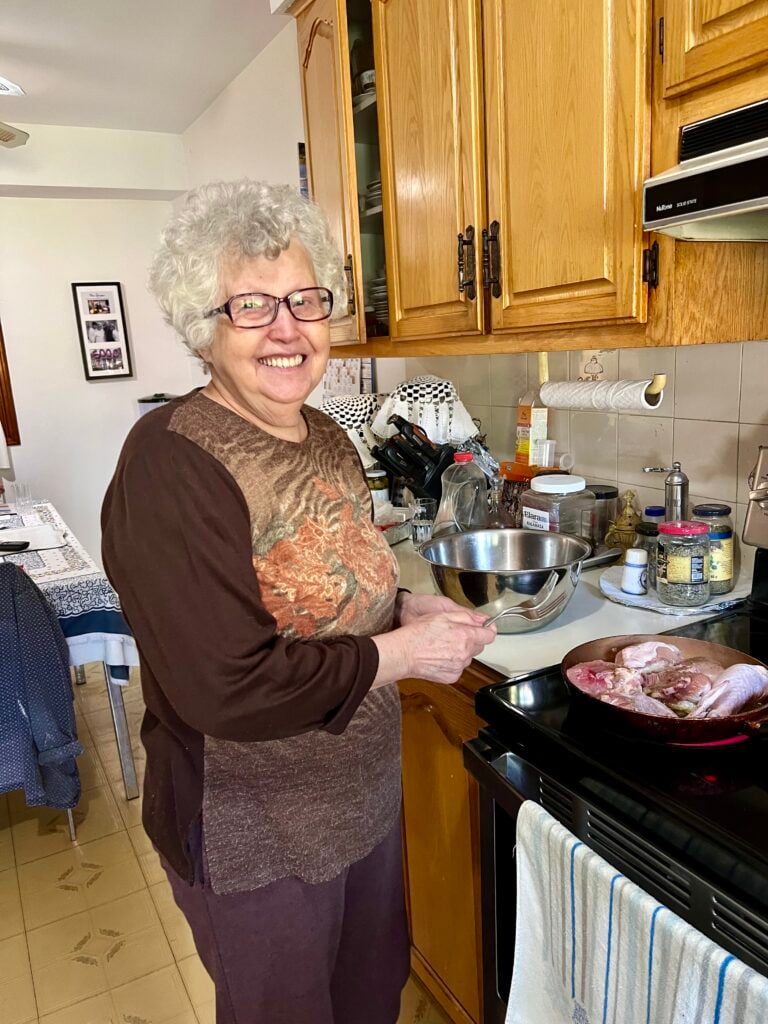
Step 2
Once all of your rooster has been browned, strain the olive oil that is left in the pan through a fine sieve to remove all the sediments. Measure the amount of oil you have and add enough to end up with 1/3 cup olive oil.
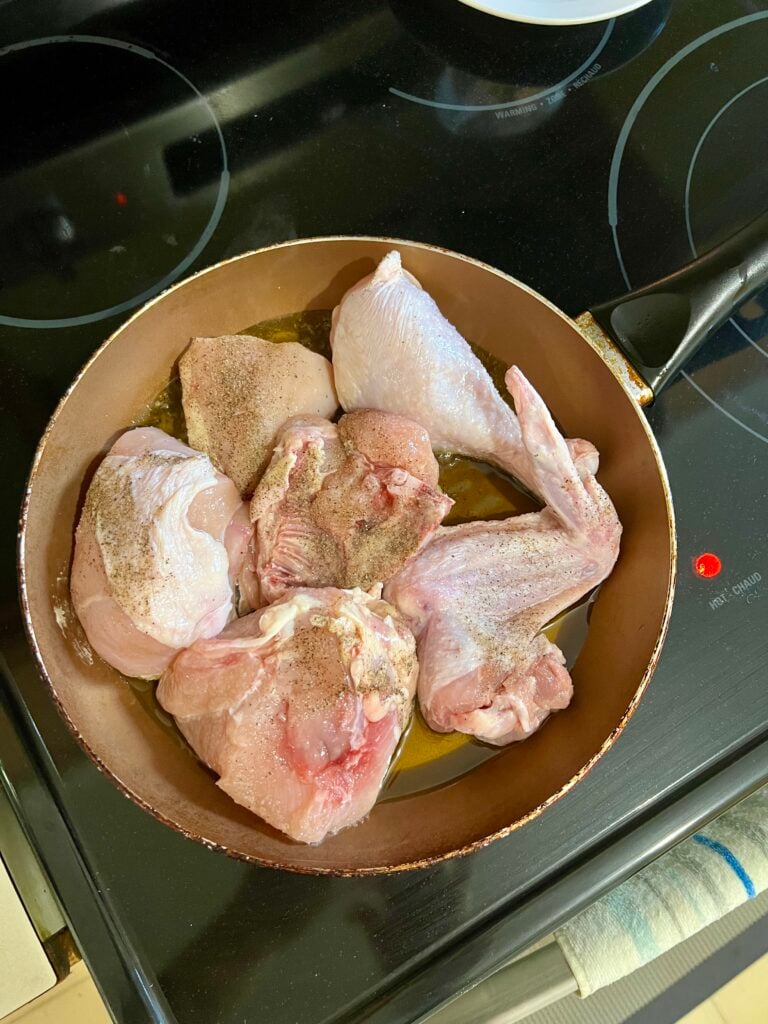
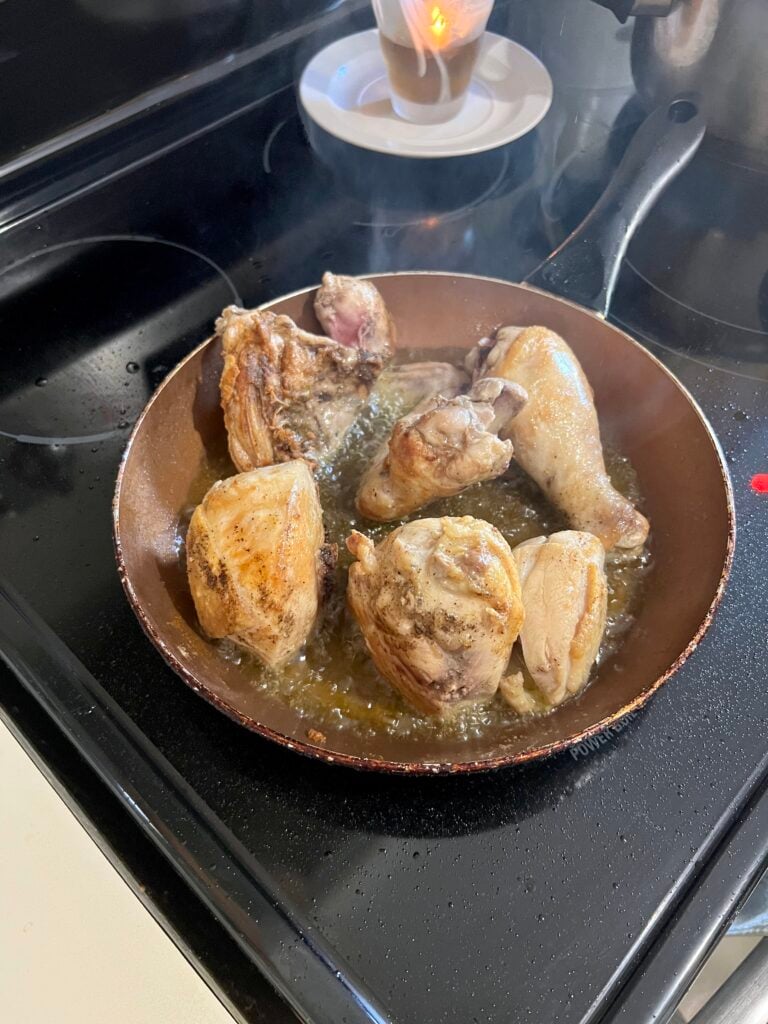
Step 3
Add the olive oil to the pot containing the rooster. Add the tomato sauce, the boiling water and the ground cinnamon.
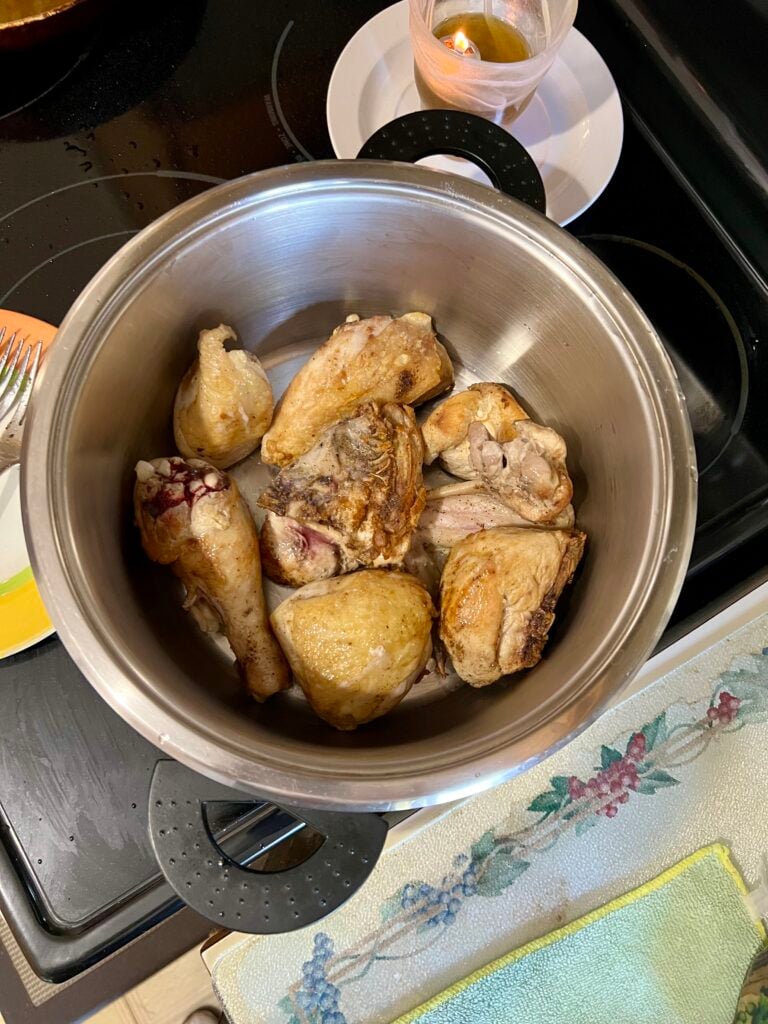
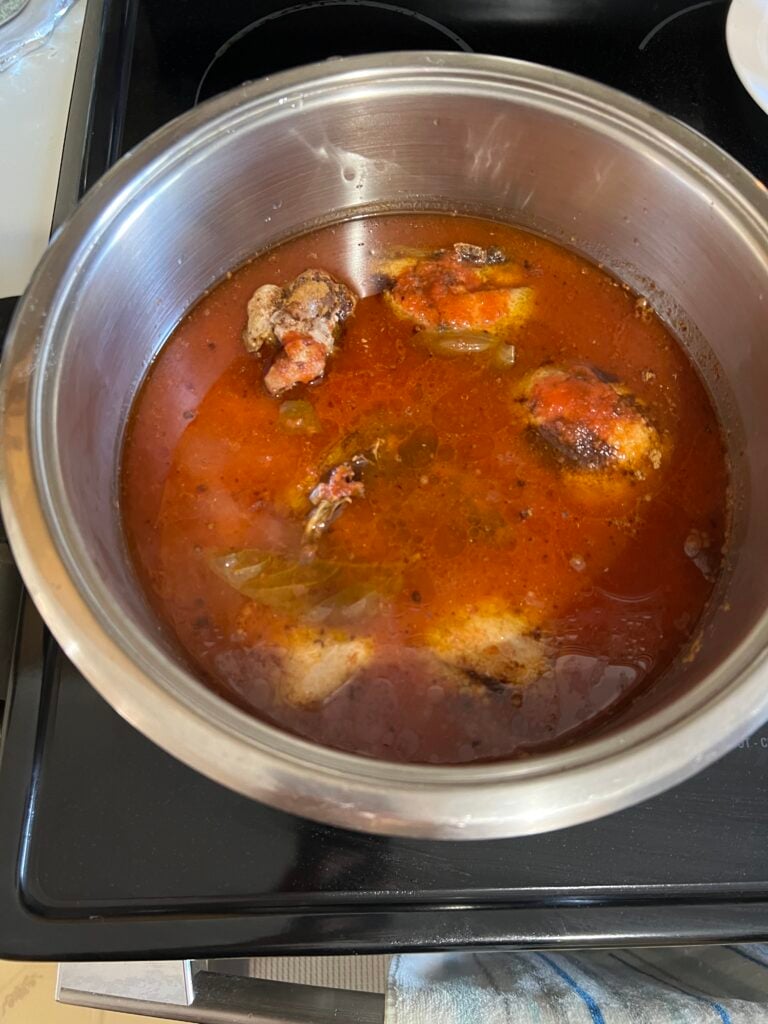
Step 4
Bring to a boil, reduce heat to medium-low and cook, covered, shaking the pot every 5 – 7 minutes. After 30 minutes, uncover the pot and continue to cook for another 30 minutes (60 minutes total) or until the rooster is cooked and the sauce has thickened.
Step 5
When your rooster is almost ready, boil the water for the pasta. Cook as directed on package.
Step 6
Drain the pasta and toss with the grated cheese. To serve, portion out the pasta and top with 1 or 2 pieces of rooster and the sauce.
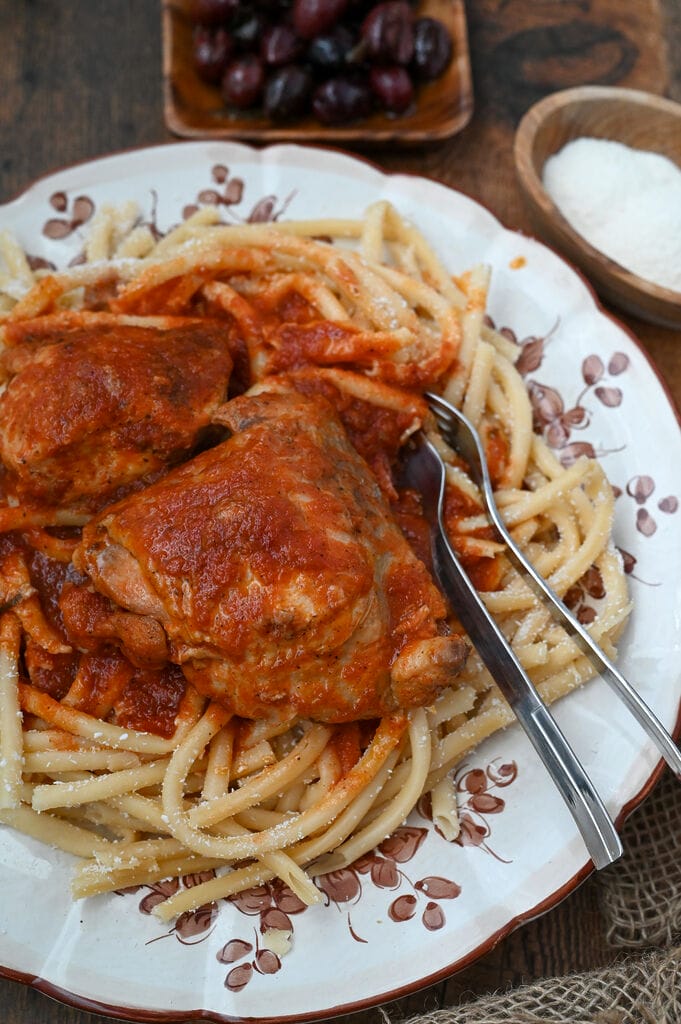
Recipe substitutions
You can make this recipe with chicken instead of rooster. You will need to adjust the cooking time as the chicken will likely cook faster.
If you don’t have mizithra cheese you can use a combination of grated parmesan and grated romano chese.
Cooking tips
When I purchase rooster, I always ask the butcher to cut it up for me into serving size pieces. This makes preparing rooster with pasta and tomato sauce (kokora me makaronia) so much easier! Also, make sure that your rooster was not previously frozen. You will likely only use half of the rooster for this recipe; you need a total of 2 1/2 to 3 pounds for 4 servings. You can freeze the other half (but not if it was previously frozen and thawed).
You will notice that in the recipe I suggest first browning the rooster on all sides. This will help keep the meat tender and will add flavour to the final meal. The rooster then cooks for a long time in the pot – approximately an hour. This is normal, and will not dry out your rooster. It cooks over low heat. Rooster takes a longer time to cook than chicken does.
You are going to cook the rooster in the tomato sauce and water for about 60 minutes total. If you notice that your sauce is getting too thick before the meal is done, add some additional boiling water, ½ cup at a time.
Serving size
This recipe will serve 4 people. You will be using 2 1/2 to 3 pounds of rooster, which will likely be half the rooster. The recipe however can easily be doubled; in this case you will likely use the entire rooster.
Frequently asked questions
What is rooster? What is the difference between rooster and chicken?
The difference between a rooster and a chicken is simple – there isn’t really one. A rooster is a male chicken. What we typically refer to as chicken (the kind you easily find in any grocery store and use to make this classic Greek meal: Roast chicken and Greek-style potatoes (Κοτόπουλο λεμονάτο με πατάτες)) is actually a hen. So, roosters and hens are both chickens: the rooster is the male, and the hen is the female. So, when you are eating chicken, you are technically eating hen. There are more details to this that you can learn about here.
Where can I purchase rooster?
Roosters are not as readily available as hens are. You may need to find a butcher who carries rooster, or you can try an Asian market as they tend to cook with rooster as well. In Montreal, I buy rooster from the place my parents introduced us too – Boucherie Zinman in Little Italy, adjacent to Jean Talon market. You can also find rooster at
What does rooster taste like?
Rooster is actually delicious. It tastes gamier than chicken does, and it tends to be much leaner. Some say that it tastes more like turkey than it does chicken. The flavour becomes more pronounced as the rooster ages.
Recipe variations
If you love the idea of this meal, but can’t find rooster or would rather not find rooster, then give this recipe for Chicken kokkinisto with pasta a try!
Another great recipe that stars rooster is this one: Stewed rooster with okra and potatoes.
If you would prefer to make this a gluten-free meal, then you can either use gluten-free pasta or serve your rooster over French fries or Greek lemon rice or even some plain white rice.
How to serve
Perfect sides for rooster with pasta and tomato sauce (Kokora me makaronia)
We always had this meal with a salad on the side. Typically we would have either a Greek lettuce salad called maroulosalata, a Greek salad or horta. You can choose from the best traditional Greek salads for more options.
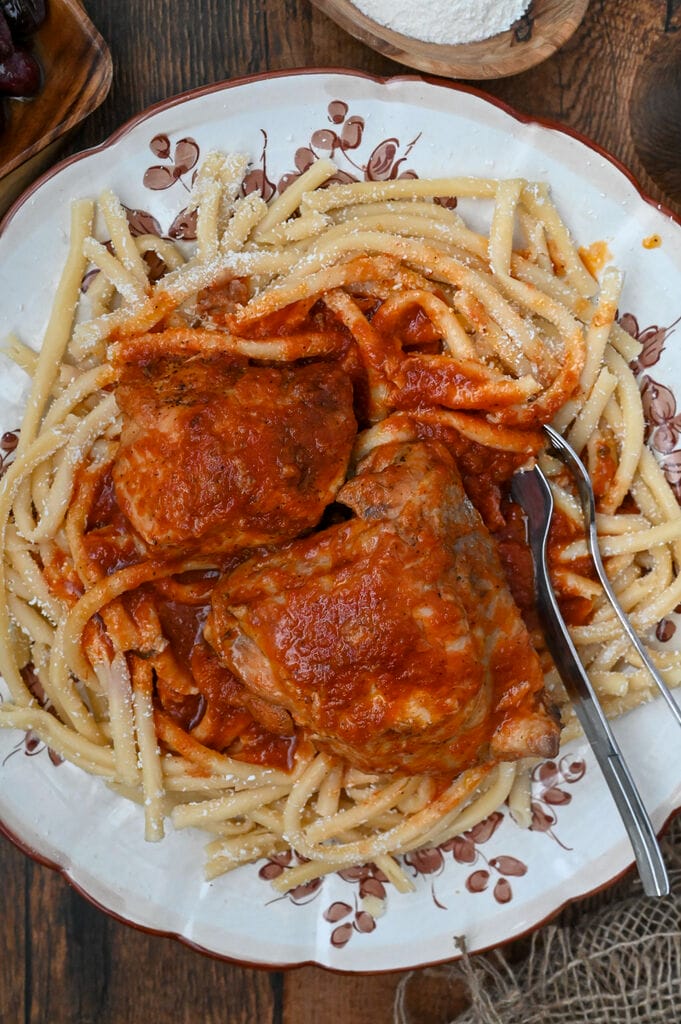
Our Family New Year Celebrations
New Year’s Day has always been a special day in our family. The start of the new year is also the feast day of Saint Basil. Those named Vasiliki and Vasili celebrate their Name Day on January 1st. If you are Greek, you may have guessed that my name, Billie, is actually a nickname. I was baptized Vasiliki. I was coined Billie by one of my older cousins when I was a baby – and it stuck.
One of my first cousins (daughter of Thea Voula of pizza and cheesecake fame) is also a Vasiliki. For many years New Year’s Day was spent at Thea Voula’s house. We would all gather for lunch, many of us having spent New Year’s Eve together, some of the older cousins having gone out to parties with friends. No matter how we spent the 31st of December, being together on January 1st was non-negotiable. And why would we want it to be? We could think of no better way to start the New Year than to be with family, playing games, talking, watching movies and eating way too much.
Unlike Easter, which tended to be a more energetic affair, New Year’s Day celebrations were more low-key. Most of us would be tired, either from going to bed very late (or early depending on how you look at things) or from the activities taking place since Christmas Eve. That period of time between December 24th and January 1st is the weirdest isn’t it? Time seems to stand still and yet also pass too quickly. Days roll into one another and it is just a series of eating, gathering, sleeping and repeat. I love it!
The most tired of course would be dear Thea Voula – she would prepare the most amazing lunch (obviously because we were all starving). There would be her pizza, but she would also serve things like spanakopita, tyropites, the famous Greek lettuce salad called maroulosalata, roast meat with potatoes (sometimes lamb, sometimes pork, sometimes both) and many more delicious and classic Greek dishes.
As the years have gone on and families have grown, we started to celebrate New Year’s Day in a different manner. We used to gather at my parents’ home, with my siblings and with our own children. Now, we gather in my home and my parents come as guests, not having to do any of the work of prepping and cooking. I try to make the spread as impressive as it used to be at Thea Voula’s and at my parents’ home. Regardless of what we pull together however, the centrepiece is this meal – rooster with pasta and tomato sauce (or kokora me makaronia as it is referred to in Greek). This was a meal that our mom and dad would have on special occasions (like New Year’s Day) in their villages, and I just love making it for them now.
Related recipes
If you love this kokkinisto meal of stewed rooster, then I know you will also enjoy these recipes:
Chicken kokkinisto with french fries
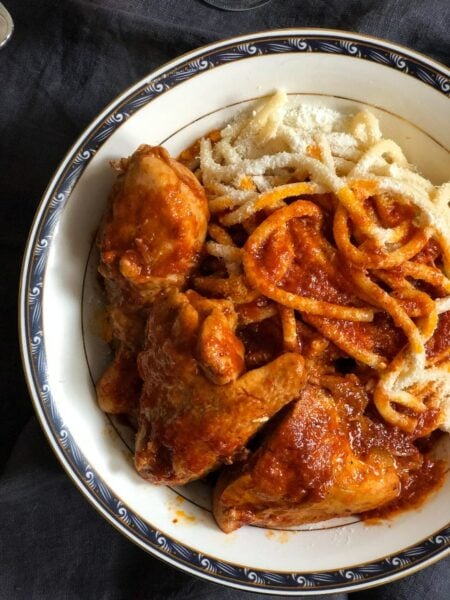
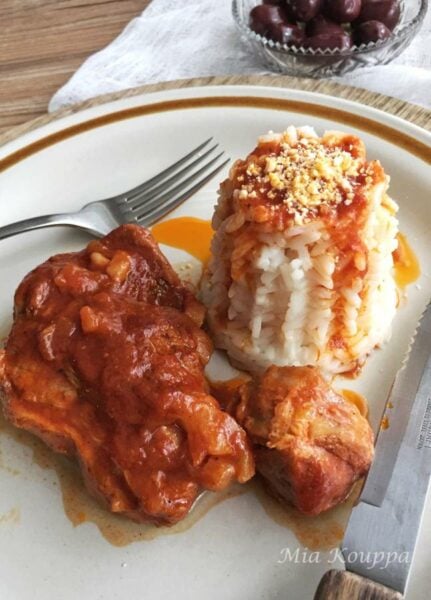
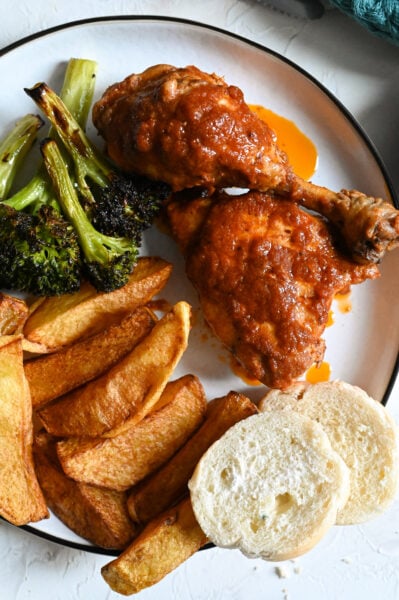
We love hearing from you! If you have made our recipes, or if you have a question or comment, or simply want to say Hi!, please leave a comment and star rating below! Also be sure to follow along with us, on Facebook, Instagram and Pinterest. We have lots of fun over there.
This post may contain some affiliate links, which means that we make a small commission off items you purchase at no additional cost to you.


Rooster with pasta and tomato sauce (Kokora kokkinisto me makaronia)
Equipment
- 1 large pot
- 1 Fine sieve
- 1 Large colander
Ingredients
- 2½ – 3 lbs rooster (see notes) cut into 6 or 7 serving pieces
- 1 tbsp salt
- ½ tsp black pepper
- olive oil to fry the rooster pieces enough to cover 1/4 inch of pan.
- 1 cup boiling water
- 3 ½ cups tomato sauce
- 1 tsp cinnamon heaping teaspoon
- 500 grams pasta of your choice we like to use bucatini for this recipe.
- ½ cup grated mizithra cheese or grated parmesan and/or romano cheese
Instructions
- Season your rooster with salt and pepper.2½ – 3 lbs rooster (see notes), 1 tbsp salt, ½ tsp black pepper
- Add olive oil to a large frying pan (enough so that you have ¼ inch of oil in pan) Heat over medium heat and add the rooster. Do not overcrowd your pan; you will likely have to do this in batches. Fry the rooster until browned on all sides (about 5 minutes per side). Transfer the rooster to a large pot.olive oil to fry the rooster pieces
- Once all of your rooster has been browned, strain the olive oil that is left in the pan through a fine sieve to remove all the sediments. Measure the amount of oil you have and add enough to end up with 1/3 cup olive oil.
- Add the olive oil to the pot containing the rooster. Add the tomato sauce, the boiling water and the ground cinnamon.1 cup boiling water, 3 ½ cups tomato sauce, 1 tsp cinnamon
- Bring to a boil, reduce heat to medium-low and cook, covered, shaking the pot every 5 – 7 minutes.
- After 30 minutes, uncover the pot and continue to cook for another 30 minutes (60 minutes total) or until the rooster is cooked and the sauce has thickened.
- If you notice that your sauce is getting too thick before the meal is done, add some additional water, ½ cup at a time.
- When your rooster is almost ready, boil the water for the pasta. Cook as directed on package.500 grams pasta of your choice
- Drain the pasta and toss with the grated cheese. To serve, portion out the pasta and top with 1 or 2 pieces of rooster and the sauce.½ cup grated mizithra cheese
- Enjoy!

This recipe is very close to what my mother used to make and we called it Kapamah. With the “a” pronounced as in “ahhh”
This was a main stay menu item for dinners my mother would prepare and we used large macaroni and lots of Parmesan chees because we did not have a source to get mizithra.
Amazing! So glad that this recipe has brought back family memories. We hope that you enjoy it! xoxo Helen & Billie